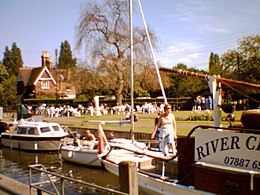Shepperton Lock

Shepperton lock (2005)
|
|
| Waterway | River Thames |
|---|---|
| County | Surrey |
| Maintained by | Environment Agency |
| Operation | Hydraulic |
| First built | 1813 |
| Latest built | 1899 |
| Length | 53.16 m (174 ft 5 in) |
| Width | 6.04 m (19 ft 10 in) |
| Fall | 2.03 m (6 ft 8 in) |
| Above sea level | 33 ft (10 m) |
| Distance to Teddington Lock |
10 miles |
| Coordinates | 51°22′55.5″N 00°27′31″W / 51.382083°N 0.45861°WCoordinates: 51°22′55.5″N 00°27′31″W / 51.382083°N 0.45861°W |
| Power is available out of hours | |
Shepperton Lock is a lock on the River Thames, in England adjoining the northern bank near Shepperton, Surrey (formerly Middlesex). It is across the river from Weybridge, but not directly accessible from there.
In 1813, the City of London Corporation built the pound lock on a cut along an existing watercourse to create Lock Island.
There are two weirs, one between Lock Island and Hamhaugh Island and the other larger one between Hamhaugh Island and the southern bank.
The Shepperton to Weybridge Ferry service runs from Ferry Lane below the lock to the end of Thames Street, Weybridge, where there are two rowing clubs and a canoeing club. Overlooking the lock and the islands is the Thames Court pub/restaurant.
A weir is recorded at Shepperton in the 1086 Domesday Book but this is unlikely to have been on the tidal Thames itself. There is also reference to a sluice or dam at Shepperton in 1293 and tolls being raised on passing ships, but the geography of the area is likely to have changed and these do not appear to refer to the site of the current lock. The lock was built in 1813 on the site of a small watercourse known as Stoner's Gut which ran across the neck of a hook in the river as it went to Weybridge. This channel was considered a nuisance to navigation and was not considered for use as the main channel as barges usually went to Weybridge or the Wey Navigation. Various accounts at the end of the 18th century record flood waters cutting through the gut and it is believed that there was a little wooden church built on piles over the river which was washed away. The gut was dammed and in 1805 came the first suggestion for a lock. After strong opposition, the proposal was put forward again in 1809 and a wooden lock was subsequently built. A stone lock was built in 1899, next to the existing wooden one which was then filled in and removed.
...
Wikipedia
